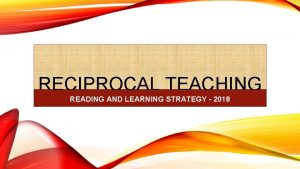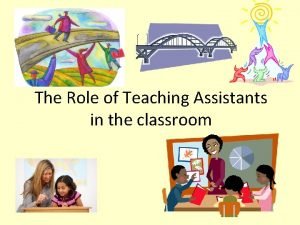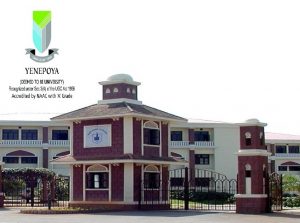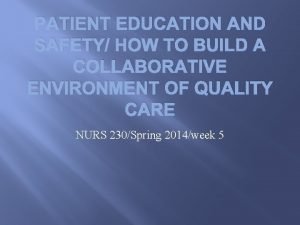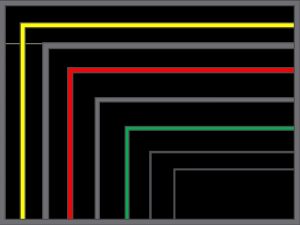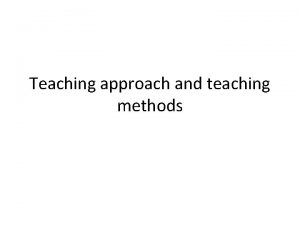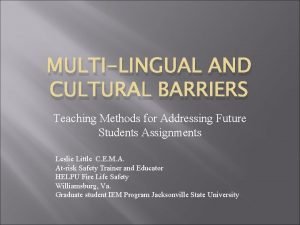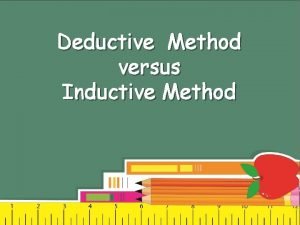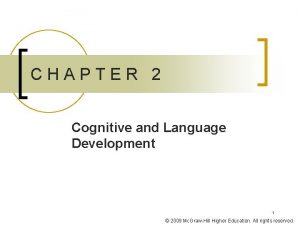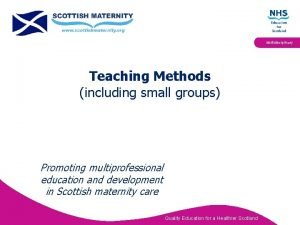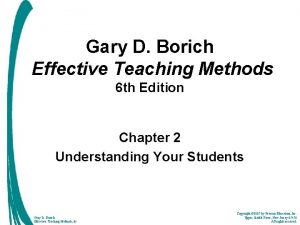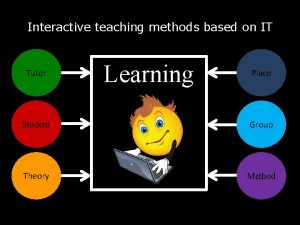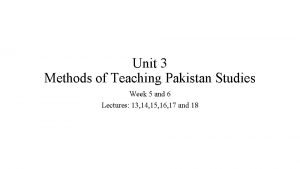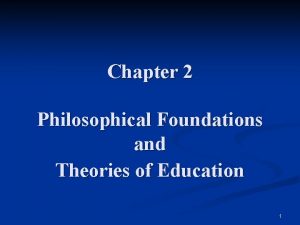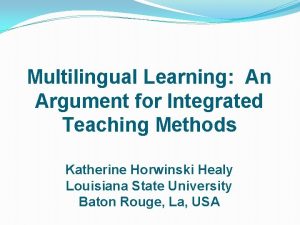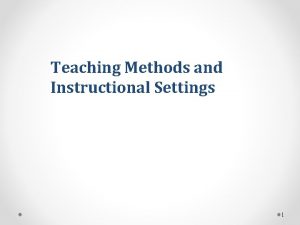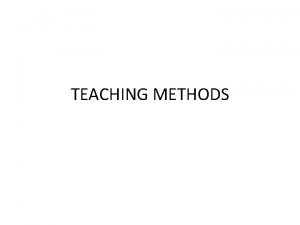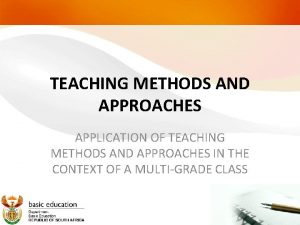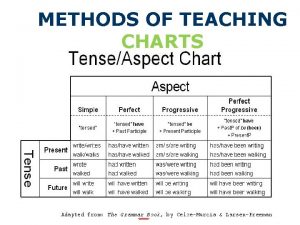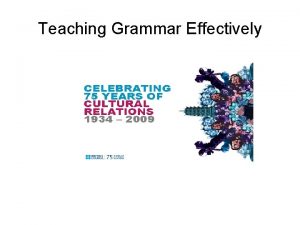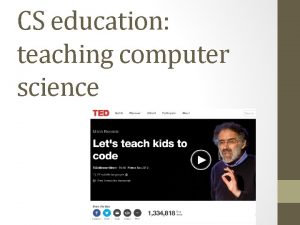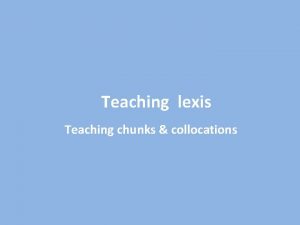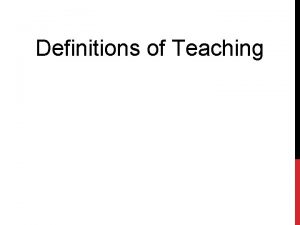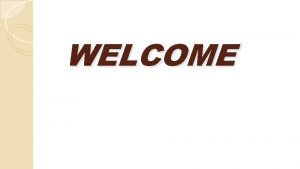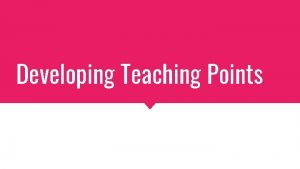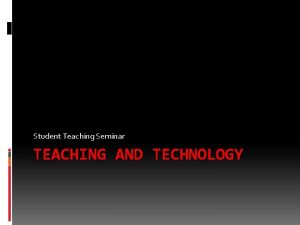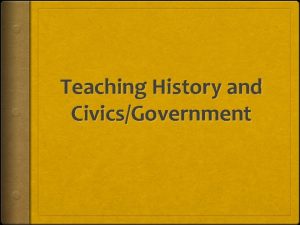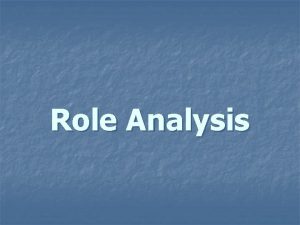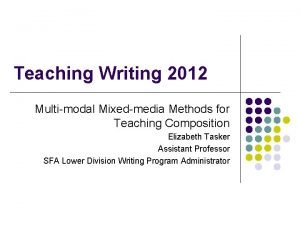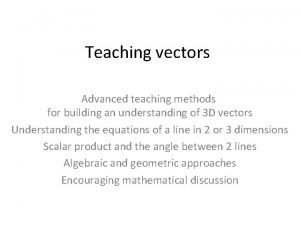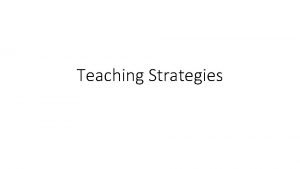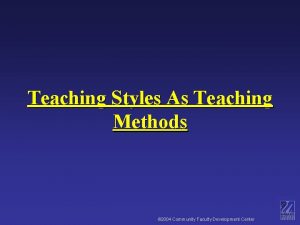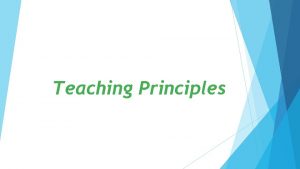METHODS of TEACHING Role of Methods A METHODS























- Slides: 23


METHODS of TEACHING

Role of Methods A. METHODS AND TEACHING B. METHODS, STRATEGIES AND TECHNIQUES C. ROLE OF METHODS D. Criteria for Method Selection E. CLASSIFYING METHODS F. GENERAL CLASSIFICATION AND THEIR CHARACTERISTICS G. BASIC STEPS FOLLOWED H. EVALUATING THE METHOD USED

Method in Teaching is defined as instructing, tutorial or educating, as a profession it is taken as a mission to mold the young. It refers to the vital role of teachers in engaging students in activities that will enable them to acquire knowledge and skills at the same time develop values and attitude.

Methods, Strategies and Techniques

Methods is a systematic plan to achieve a learning objectives, it is a procedure that must follow strictly to attain the goal. It is a well- planned procedure that guide the direction in undertaking in learning activities.

Strategy stand for a carefully devised plan of action to achieve an objectives in the battlefield. Techniques the art style or manner of a teacher’s performance in following a procedure , it includes ones ability or expertise in carrying out a task in a cautions and watchful ways.

ROLE OF METHODS As a clearly defined way of teaching, various methodologies present unique courses of action that will help teacher immensely in planning how to go about a daily lesson Deciding on methods to be used assists in a number of ways:

1. It serves as a guide in preparing all the materials, simple tools and equipment that will be needed. The availability amount will be determined ahead of time. 2. The activities or learning tasks that will be perform could be determined, including the approximate time to be allotted for each and the proper sequencing to be followed.

3. How the activities will be perform in order to progress in the right direction will be clearly understood anticipated by the leaders if some are assigned. 4. A method that would require movement from one place to another will be planned with much care to avoid.

5. The instructional objective that would be highlighted will dictate the method to be employed. 6. The method will serve as a guide in observing performance indicators 7. The method employed could help plan the assessment instrument that could reveal whether the objectives has been achieved.

8. A well- planned procedure will add to a strong feeling of confidence and security for the teacher as well for the students. 9. It is so fulfilling and gratifying for a teacher to develop competence in deciding on a method to use and implementing it successfully.

Criteria for Method Selection 1. Objectives to be Purchase 2. Subject to be taught 3. Instructional Equipment, Tools and Materials 4. The Students Abilities 5. The Students Interests 6. Previous Learning or Experiences 7. The Kind of Participation Excepted 8. Context of the Teaching Situation 9. Knowledge and Ability of the teaching 10. Safety Precautions

Methods of Selection Map SUBJECT MATTER OBJECTIVES (Nature and scope) (Knowledge, Skills , Values) CONDUCIVE LEARNING ENVIRONMENT (lab, room, garden) CRITERIA FOR METHOD SELECTION ACCESS TO TECHNOLOGY (Appropriate Instructional Materials and devices) STUDENTS ABILITY (interest, needs and experiences TEACHERS COMPETENCE (Professional Skill and Personal traits) Factors That affects Decision on Method to be used.

CLASSIFYING METHODS Teaching methods may be classified as to the following 1. Where suitable undertaken a. In the laboratory room Examples: Experimenting, Problem Solving, Discovery, Students Research b. In the field/ community Examples: Field Study, Exploring community resources

2. Focused Participants: Individual or Group Examples: Inviting specialist. Lecture, teamteaching, cooperative learning, writing journals, peer-tutoring 3. Action- based Examples: Role playing, sociodrama, simulation game, projects, direct instruction 4. Technology based Examples: Using audiovisual media, experiential teaching approach, microteaching

5. According to goals COGNITIVE Examples: Research, special reports, lecture, readings AFFECTIVE Examples: Writing journals, narrative, cooperative learning, creative writing PSYCHOMOTOR Examples; Experimenting, projects, simulation, collection 6. According to time available 1. Class period, Examples: Demonstration, inviting specialist, 2 or 3 days, Examples: Field trip,

General Classification and their Characteristics Methods and techniques employed by teachers can be described and labeled as traditional or progressive. Following are the observed description and characteristics of each. 1. Traditional Method 2. Progressive Method

Traditional Method Progressive Method 1. Objectives Subject – centered – goal is mastery of content Student – centered – goal is gain to knowledge, development skills and instill values. 2. Teacher Facilities, guides and encourage more student They are subject matter expert and sequencing participation is strictly 3. Content Use teacher – organization content and sequencing is strictly to be followed Content is flexible and may include related subjects as in an integrated teaching 4. Implementation Step – step procedures in lesson activities is strictly followed and teacher - directed Allows substitution of materials during the activities if needed. Alternative steps are undertaken to avoid misdirection or delay 5. Evaluation Uses objective test and other Quantitative measures Uses Qualitative assessment tools such as informal observation, interviews and discussions.

Basic Step to be Followed 1. Initial Preparation 2. He gathers all the materials that will be need, Prepares them in the right amount and arranges them on the table nearby for accessibility 3. Motivation Phase 4. Lesson Proper 5. He observes How they are Progressing from one activity to another 6. Summarizing phase 7. Assessment 8. Evaluation

Evaluating the Method Used 1. Purpose 2. How can a Method be Evaluated?

Method and Teaching Thank you!!!!

. Reference Method of teaching Revise by Gloria G Salandanan LORI MAR Publisher. p. 14 – 22
 What is web role and worker role in azure
What is web role and worker role in azure Interaktionistisches rollenmodell
Interaktionistisches rollenmodell Statuses and their related roles determine
Statuses and their related roles determine Reciprocal teaching role cards
Reciprocal teaching role cards Role of a teaching assistant
Role of a teaching assistant Micro teaching principles
Micro teaching principles Role of nurse in patient teaching ppt
Role of nurse in patient teaching ppt Difference between traditional teaching and micro teaching
Difference between traditional teaching and micro teaching Selection of teaching methods
Selection of teaching methods Characteristics of good teaching methods
Characteristics of good teaching methods Multilingual teaching methods
Multilingual teaching methods Direct or expository approach
Direct or expository approach Remedial activities for slow learners
Remedial activities for slow learners What is deductive method
What is deductive method Piaget teaching methods
Piaget teaching methods Set dialogue closure
Set dialogue closure Gary borich
Gary borich Interactive teaching methods
Interactive teaching methods Unit method of teaching
Unit method of teaching Method of teaching slideshare
Method of teaching slideshare Pragmatism teaching methods
Pragmatism teaching methods Innovative methods of teaching english language
Innovative methods of teaching english language Multilingual teaching methods
Multilingual teaching methods Teaching methods definition
Teaching methods definition



